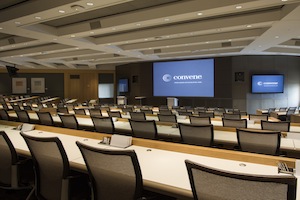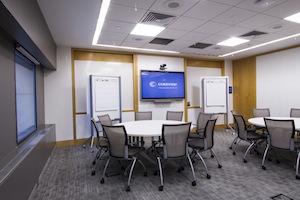NEW YORK, NY—The craving for face time is instinctual for people, and like anything humans are into, we keep striving to do it better and better. In the business world, that translates into a quest for the best meeting possible, allowing ideas to flow freely and gel into well-organized plans of action.

The sensory experience that Convene’s guests control is comprehensive, especially in the diamond-shaped main auditorium. There, an 18-foot diagonal rear-projection screen is situated in the front of the space, flanked by two 90-inch LED screens on each side, with two more 60-inch displays in the back of the room.
In New York City, a company known as Convene has made a multimillion-dollar investment in large-scale corporate gatherings. In fact, it recently transformed the Financial District address of 32 Old Slip into an advanced meeting place that’s available for one- or multi-day bookings. A 36,000 square foot space, Old Slip provides a 212-seat auditorium and a dozen more breakout rooms for brainstorming, shareholder meetings, employee orientations, and any other large-scale meet up that today’s leaner companies may not have the real estate to host themselves.
Not surprisingly, Convene sees AV as being at the core of its mission. “Companies are becoming more reliant on AV capability to put their meetings together,” observed Ryan Simonetti, who co-founded Convene (originally Sentry Centers) in 2009 together with Chris Kelly. “Today’s meetings are highly integrated, not only physically but technologically, bridging to another audience in another location, or one online. To make meetings more collaborative and interactive, we’re seeing an increased connection between AV technology and the meeting itself.”
The AV designer and integrator on the project was Connecticut-based HB Communications, which helped Convene create a space where ease-of-use, along with the ability to capture and redistribute content generated at Old Slip, were primary objectives. “The rooms had to be simple, controllable, and very serviceable if the need presents itself,” said Dave Fretz, senior account executive for HB Communications. “The whole notion was to make rooms as simple as possible for the users so they could walk in, walk up to the touch panel controls, and operate it easily with no technical help.”
Fretz laid down interesting guidelines for the HB Communications team that was programming Old Slip��s Crestron control system. “We try our best not to think like AV people!” he explained. “We want to simplify the experience, and assume that the person walking in there has no idea of how a control system works. Fortunately, with the advent of iPhones, iPads, and tablets, people are much less afraid of touch panel control surfaces than they were before. Convene is huge on getting client feedback—they have a questionnaire for everyone who moves through the space—so they’ll be proactive on the ongoing simplification of the systems.”
The sensory experience that Convene’s guests control is comprehensive, especially in the diamond-shaped main auditorium. There, an 18-foot diagonal rear-projection screen is situated in the front of the space, flanked by two 90-inch LED screens on each side, with two more 60-inch displays in the back of the room. Wireless Sennheiser mics, plus additional microphone support when called for, along with a full surround system with subwoofers and additional ceiling speakers, provides the sound component. Meanwhile, Cisco videoconferencing and Polycom audioconferencing connects the large conference room to the outside world.

Old Slip’s 12 smaller breakout rooms are all connected to the head-end control system, making them useful for overflow as well as standalone spaces. In addition, touch overlay LCD screens with whiteboard capabilities make these rooms particularly useful for small-group brainstorming.
Old Slip’s 12 smaller breakout rooms are all connected to the head-end control system, making them useful for overflow as well as standalone spaces. In addition, touch overlay LCD screens with whiteboard capabilities make these rooms particularly useful for small-group brainstorming. “You can have a truly collaborative experience with the people in the room,” said Fretz, “annotating up on the screen, making notes, and adjusting things on the fly, as opposed to just working on your laptop and displaying it. That gets everyone involved in the meeting, and maximizes the efficacy of the space.”
Nothing at Convene happens in a vacuum—the AV was planned with the ability to record all audio and video, and then distribute via the internet or over a secure bridge to another corporate location, if desired.
“Historically, AV and IT ran as parallel-but-separate businesses, but today they’re very much intertwined because all AV equipment is supported by a network,” Simonetti noted. “At Old Slip, we invested on the infrastructure side so we have the storage capacity and bandwidth to capture as much content as needed, and then have the ability to move it through a cloud-based app or direct bridge. On the AV side, we invested in sufficient audio and video equipment to be sure we’ve captured everything that’s physically going on in the spaces.”
Digital signage throughout Old Slip, displayed via LCD displays and individual room schedulers, facilitates way-finding and scheduling for guests on the move. Put together with the sophisticated rooms, it adds up to an AV-enabled space that’s designed to change rapidly the times. “As soon as technology is ready for prime time, that’s what we’ll be incorporating into the center,” Dave Fretz said. “A lot of companies are set up for an equipment refresh every seven to 12 years, but Convene is dedicated to bringing the most up-to-date technology to the client. Whatever’s new and awesome, we’ll be able to drop it in and have that be a part of the visitors’ experience.”
“We want to be the place where people execute their most productive ideas, and get their work done,” Ryan Simonetti added. “When you see the space doing what it was designed to do, with people collaborating at a high level, that’s what’s most rewarding for us a company. AV technology will continue to be an ever-larger part of how we accomplish that.”
David Weiss (www.dwords.com) writes extensively about AV, audio, and broadcast technology.